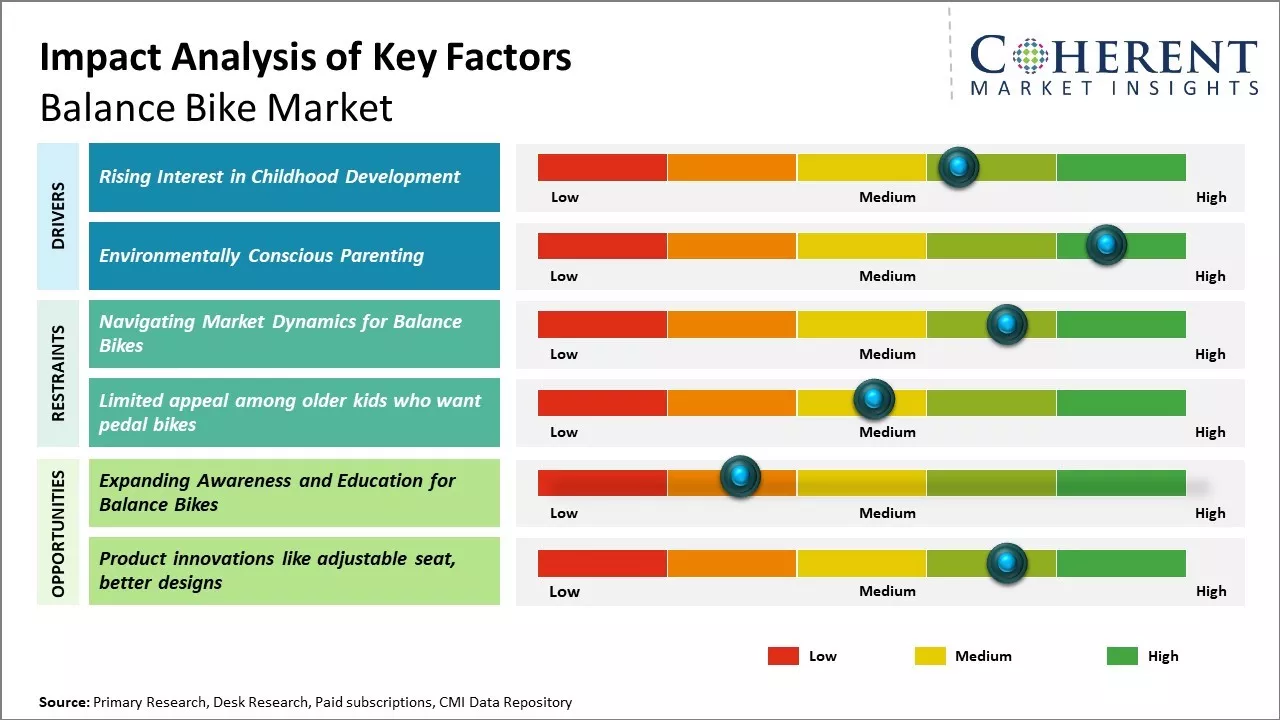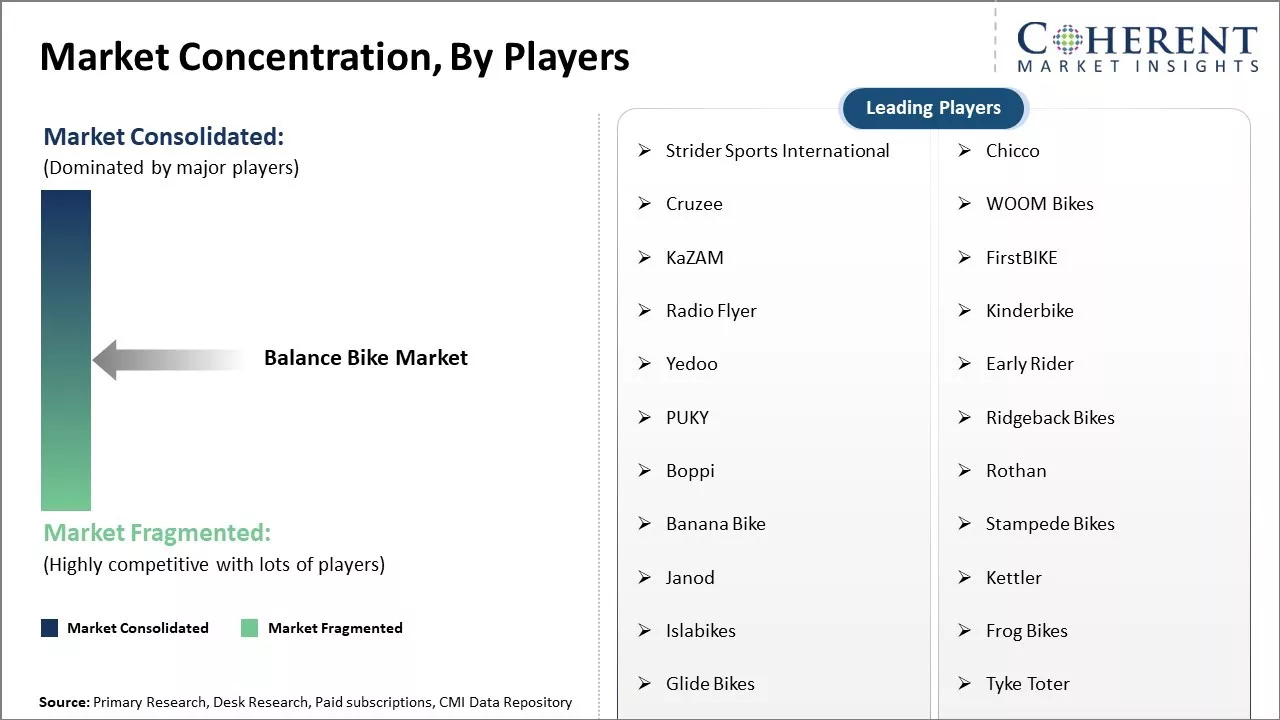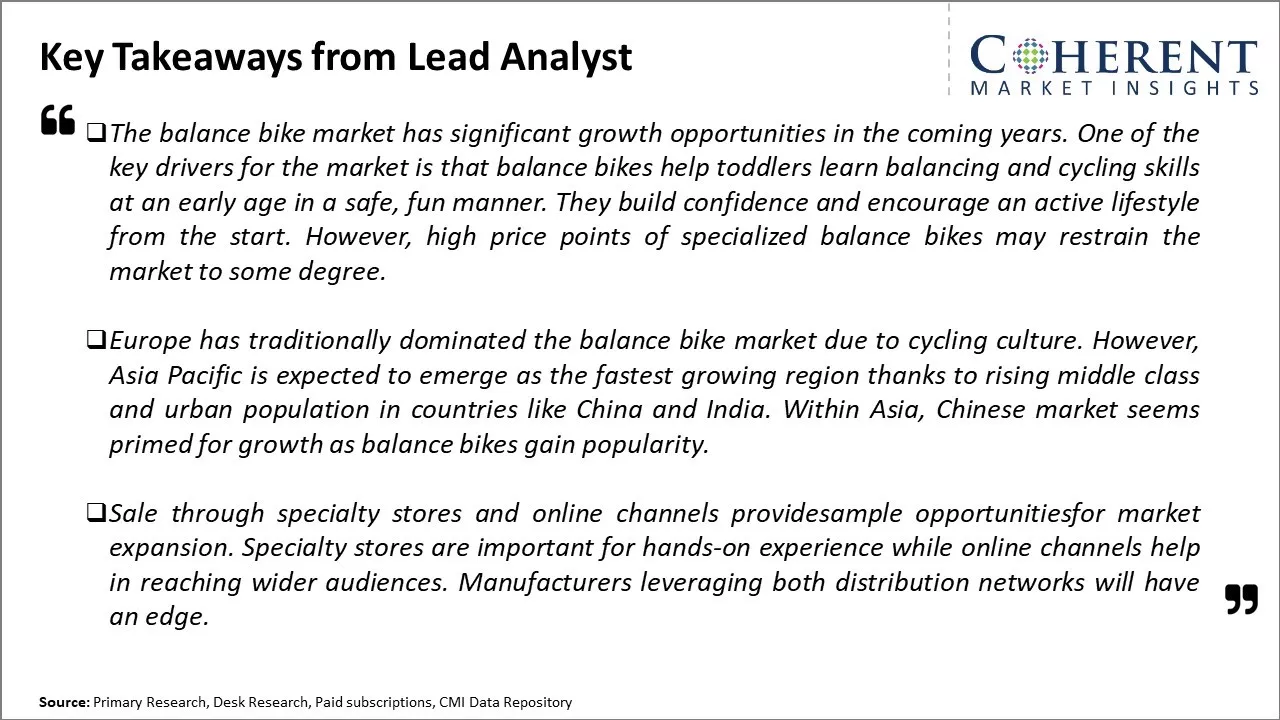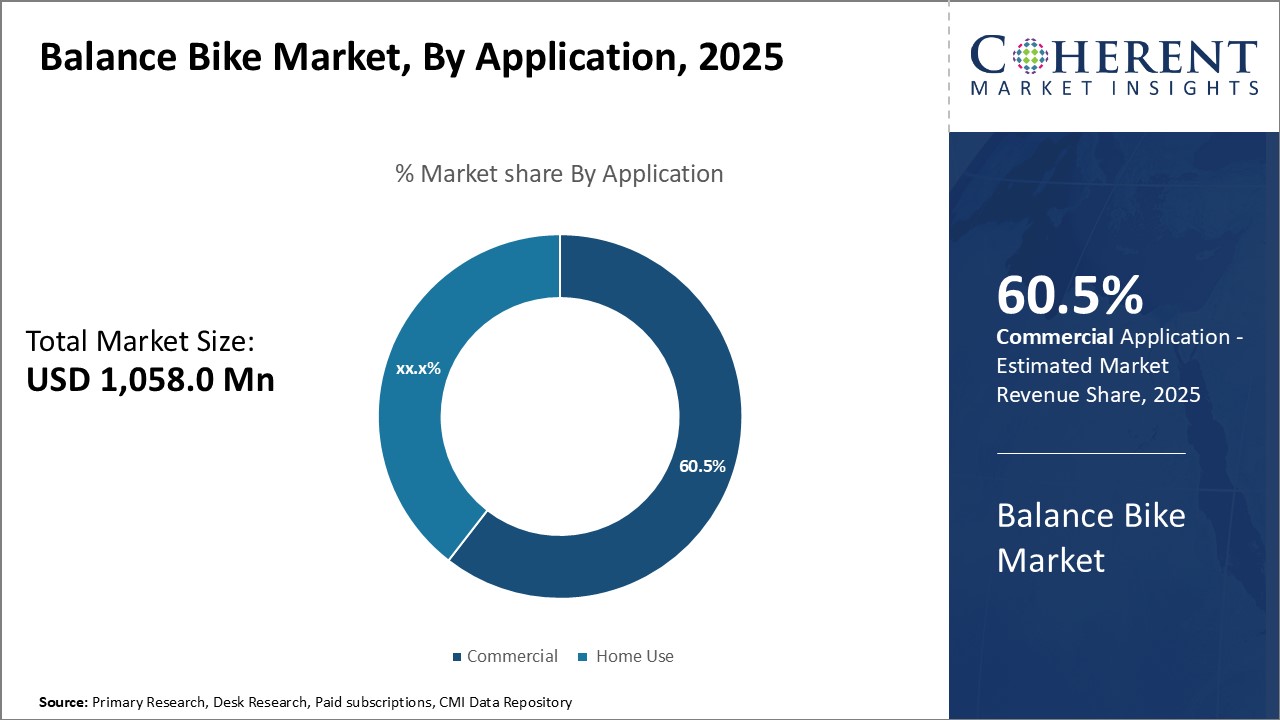Balance Bike Market Size and Trends
The balance bike market is estimated to be valued at US$ 1,058.0 Mn in 2025 and is expected to reach US$ 1,700.0 Mn by 2032, growing at a compound annual growth rate (CAGR) of 7.0% from 2025 to 2032.

Discover market dynamics shaping the industry: Download Free Sample
The balance bike market has been witnessing significant growth over the past few years owing to the rising popularity of cycling among kids and parents who desire to introduce children to cycling basics in a safe and fun environment. Furthermore, balance bikes help kids develop important skills for riding pedal bikes such as balancing, steering, and gaining confidence at young age without needing pedals. Unlike tricycles which promote dependency, balance bikes facilitate independent riding and help kids learn the fundamentals of riding a bike faster. Various tech-enabled features such as app connectivity and usage tracking have also bolstered their demand among trend-setting parents across regions.
Market Concentration and Competitive Landscape

Get actionable strategies to beat competition: Download Free Sample
Rising Interest in Childhood DevelopmentBalance bikes have gained significant popularity as parents seek activities to aid in the development of their young children. Experts widely agree that balance bikes provide a range of cognitive and physical benefits when introduced to children at an early age. Using a balance bike encourages toddlers to build confidence through balancing and steering without training wheels or pedals that could serve as a crutch. This allows children to progress at their own pace as their coordination and balance improves. Balance biking also develops important life skills for children such as discipline and responsibility as they learn to follow basic traffic rules in a safe environment.
For busy parents balance bikes offer a convenient and engaging way for children to stay active outdoors. Many families appreciate that balance biking can be done just about anywhere so it provides an easy activity for children that does not require being driven to and from structured lessons or playgrounds. Balance bikes allow kids freedom to explore their neighborhood streets and paths giving them a sense of adventure while parents can relax knowing their child is learning important lessons close to home. As parents increasingly seek developmental toys and activities designed to stimulate young minds, the simple yet effective characteristics of balance biking have contributed to its popularity growth. Its ability to offer educational fun in an easy going manner aligns well with priorities of contemporary families.
Environmentally Conscious Parenting
In recent years, there has been a noticeable increase in parents who wish to raise their children with an awareness and appreciation for environmental issues. This desire to instill eco-friendly values has guided purchase decisions for many products aimed at toddlers and kids. Balance bikes cater well to these environmentally conscious parents. Unlike tricycles or other plastic riding toys, balance bikes are typically made of sustainable materials such as wood and aluminum making them an earth-friendly choice. Many balance bike companies now emphasize the natural, recyclable elements of their product designs to appeal to green consumers.
Riding a balance bike is also an eco-friendly mode of transportation that encourages outdoor physical activity without fuel emissions. As kids gain confidence on their balance bikes they can accompany parents or caregivers on local errands by bike instead of being transported primarily by car. This introduces children to alternative transit methods from a young age which aligns with environmentalist goals for developing sustainable transportation habits. Practicing balance biking as a family fosters valuable bonding time while reducing reliance on motor vehicles for short trips.

To learn more about this report, Download Free Sample
Market Challenges: Navigating Market Dynamics for Balance BikesThe balance bike market faces challenges from substitute products like tricycles and riding toys that serve a similar purpose for toddlers. Many parents are unfamiliar with balance bikes and see them only as unnecessary expenses at a young age when kids will soon transition to pedal bikes. Establishing balance bikes as an essential part of learning to ride a pedal bike long-term can be difficult against substitutes marketed for shorter-term engagement.
Market Opportunities: Expanding Awareness and Education for Balance Bikes
The balance bike market has opportunities to grow further by increased education of parents around the importance of balance bikes for developing key riding skills at an early age. Emphasizing how balance bikes create a foundation and make the transition to pedal bikes smoother can help increase adoption rates. Partnerships with pediatric organizations could help disseminate these benefits more widely to parents.

Discover high revenue pocket segments and roadmap to it: Download Free Sample
Insights, By Application- Practicing Cycling At Home Helps Foster Early Skills In RidingIn terms of application, home use contributes 60.5% market share the highest share of the balance bike market as it allows children to develop essential balancing skills in a safe, familiar environment. At home, kids can spend time each day comfortably honing this ability through self-motivated play without traffic or road hazards distractions. Starting cycling practice in the security of their driveway or backyard helps children gain self-assurance on their balance bike away from potential accidents. It also lets parents closely oversee progress. Regular home use efficiently turns sporadic outdoor sessions into consistent daily development of equilibrium control, seat positioning and start/stopping coordination. Mastery of these fundamentals at home establishes confidence critical for future pedaling outdoors. The low-pressure, accessible nature of home cycling drives ongoing sales as it efficiently nourishes riding aptitude from an early age.
Insights By, Distribution Channel- Pedaling Practice Becomes More Accessible With Offline Availability
In terms of distribution channel, offline contributes 65.5% market share the highest share of the balance bike market by making these riding aids accessible through traditional retail avenues. Many parents feel more comfortable purchasing balance bikes in person where they can see, touch and test different models before buying. Local bike shops and toy stores give parents a hands-on experience of how balance bikes function along with expert advice. This helps increase confidence in selecting the appropriate size and features for a child's skill level. Offline stores also enable impulse buys when kids try out display models in actual stores. Proximity to neighborhood retail gives parents a convenient solution when kids are ready to start practicing balance anytime. The offline availability of balance bikes at stores nationwide drives continuous demand through spontaneous purchases fueled by children's interest.
Insights By Products- Convenience and Durability Drive the Metal Balance Bike Demand
In terms of products, metal bikes 40.5% contributes the highest share of the balance bike market owing to their convenient lightweight design and long-lasting durability. Metal bikes allow children to focus on balancing without struggling with the weight of the bike. Their lightweight aluminum frames are sturdy yet easy for kids to maneuver as they learn. Metals like aluminum also withstand the wear and tear of outdoor riding better than other materials. Kids can ride metal balance bikes on any terrain without parents worrying about damage over time from cracks or scratches. Metals are also weather resistant, so balance bikes retain their shape and functionality even after exposure to rain or sun. Additionally, metal parts are replaceable should any components need repair down the road. The durability of metal balance bikes provides parents long-term value for repeated use by siblings or resale once kids outgrow them. Their hardiness and longevity as a learning toy drive ongoing demand from cost-conscious families.
Regional Insights

Need a Different Region or Segment? Download Free Sample
North America have market share of 49.4% and established itself as the dominant region in the global balance bike market. The U.S., in particular, has a large and mature market with many established manufacturers and retailers. Some of the top brands in balance bikes such as Strider and Joovv have a strong market presence across the U.S. The widespread popularity of cycling as a recreational activity and the growing popularity of cycling among children has been a major driver of demand. Many schools and parks in cities have added balance bike lanes and circuits to promote cycling at a young age. This has created a self-sustaining cycle with more kids and parents becoming interested in balance bikes.
Exporting balance bikes to other markets has also risen with North American brands establishing distribution networks in Europe, Asia Pacific, and other regions. While locally manufactured balance bikes address domestic demand, imports from Asian countries offer cheaper price points. This has allowed the industry to serve customers across various price segments. Numerous trade shows take place every year where global buyers meet North American brands, facilitating cross-border sales. With a consolidation phase underway in the market, larger players are looking to expand their global footprint as well.
The Asia Pacific region, especially China, is emerging as the fastest growing market for balance bikes globally. Rapid urbanization and rising affluence levels have boosted cycling as a mainstream recreational activity in major Chinese cities. With over 100 million kids under 14, China presents a massive potential customer base. Local manufacturers are producing affordable balance bikes to cater to this vast domestic demand. They are able to undercut Western brands on price while improving quality through scale of operations. At the same time, brands from Taiwan, Japan, and Australia are also targeting this Asian growth market through strategic partnerships with Chinese retailers and distributors. The strong Made-in-China image and cost advantages will ensure Asia-Pacific soon challenges North America’s position as the dominant force in the global balance bike Market.
Market Report Scope
Balance Bike Market Report Coverage
| Report Coverage | Details | ||
|---|---|---|---|
| Base Year: | 2024 | Market Size in 2025: | USD 1,058.0 Mn |
| Historical Data for: | 2020 To 2024 | Forecast Period: | 2025 To 2032 |
| Forecast Period 2025 to 2032 CAGR: | 7.0% | 2032 Value Projection: | USD 1,700.0 Mn |
| Geographies covered: |
|
||
| Segments covered: |
|
||
| Companies covered: |
Strider Sports International, Chicco, Cruzee, WOOM Bikes, KaZAM, FirstBIKE, Radio Flyer, Kinderbike, Yedoo, Early Rider, PUKY, Ridgeback Bikes, Boppi, Rothan, Banana Bike, Stampede Bikes, Janod, Kettler, Islabikes, Frog Bikes, Glide Bikes, Tyke Toter, Chillafish, and Scoot and Ride |
||
| Growth Drivers: |
|
||
| Restraints & Challenges: |
|
||
Uncover macros and micros vetted on 75+ parameters: Get instant access to report
Market Segmentation
- Application Insights (Revenue, US$ MN, 2020 – 20`31)
- Commercial
- Home Use
- Products Insights (Revenue, US$ MN, 2020 - 2032)
- Metal bikes
- Wood bike
- Other
- Distribution Channel Insights (Revenue, US$ MN, 2020 - 2032)
- Online
- Offline
- Regional Insights (Revenue, US$ MN, 2020 - 2032)
- North America
- U.S.
- Canada
- Latin America
- Brazil
- Argentina
- Mexico
- Rest of Latin America
- Europe
- Germany
- U.K.
- France
- Italy
- Russia
- Rest of Europe
- Asia Pacific
- China
- India
- Japan
- Australia
- South Korea
- ASEAN
- Rest of Asia Pacific
- Middle East & Africa
- GCC Countries
- South Africa
- Rest of Middle East & Africa
- North America
- Key Players Insights
- Strider Sports International
- Chicco
- Cruzee
- WOOM Bikes
- KaZAM
- FirstBIKE
- Radio Flyer
- Kinderbike
- Yedoo
- Early Rider
- PUKY
- Ridgeback Bikes
- Boppi
- Rothan
- Banana Bike
- Stampede Bikes
- Janod
- Kettler
- Islabikes
- Frog Bikes
- Glide Bikes
- Tyke Toter
- Chillafish
- Scoot and Ride
Share
Share
About Author
Ameya Thakkar is a seasoned management consultant with 9+ years of experience optimizing operations and driving growth for companies in the automotive and transportation sector. As a senior consultant at CMI, Ameya has led strategic initiatives that have delivered over $50M in cost savings and revenue gains for clients. Ameya specializes in supply chain optimization, process re-engineering, and identification of deep revenue pockets. He has deep expertise in the automotive industry, having worked with major OEMs and suppliers on complex challenges such as supplier analysis, demand analysis, competitive analysis, and Industry 4.0 implementation.
Missing comfort of reading report in your local language? Find your preferred language :
Transform your Strategy with Exclusive Trending Reports :
Frequently Asked Questions
EXISTING CLIENTELE
Joining thousands of companies around the world committed to making the Excellent Business Solutions.
View All Our Clients
